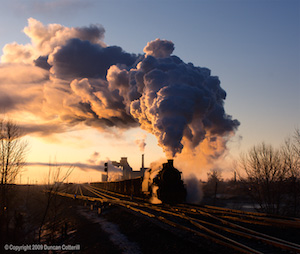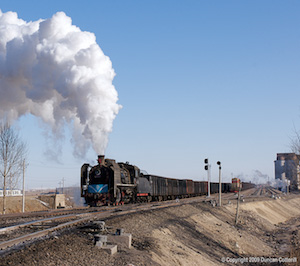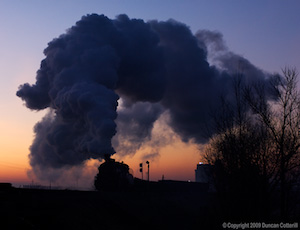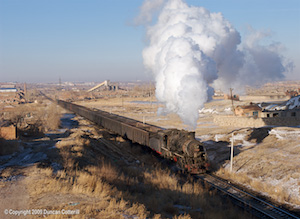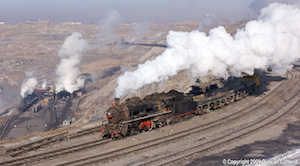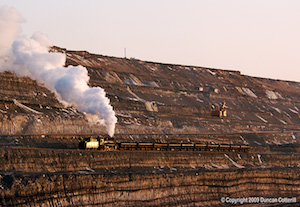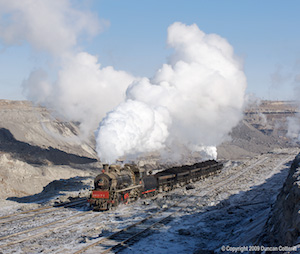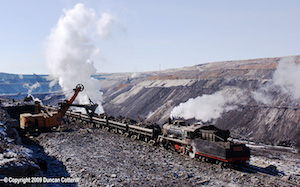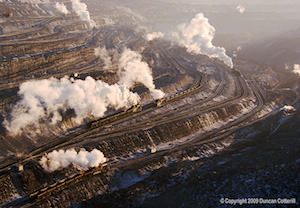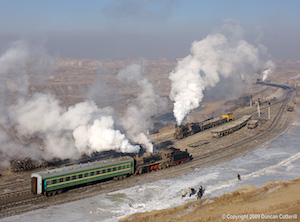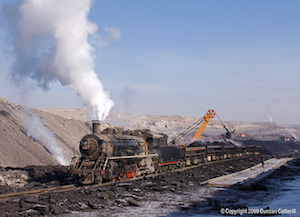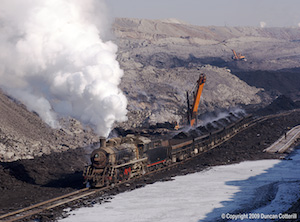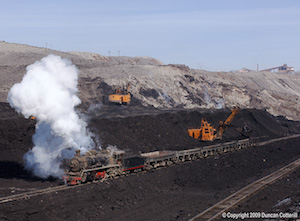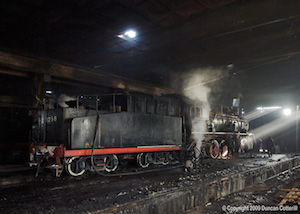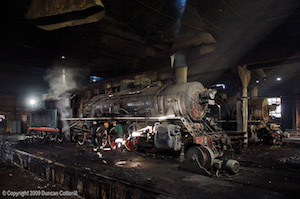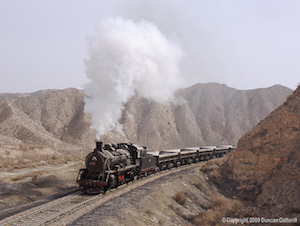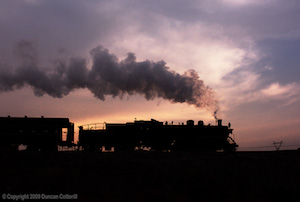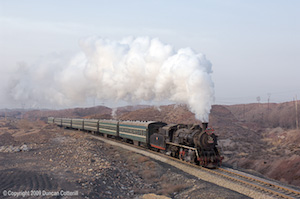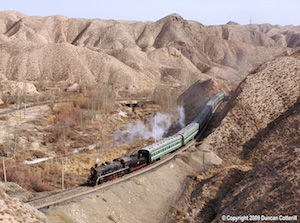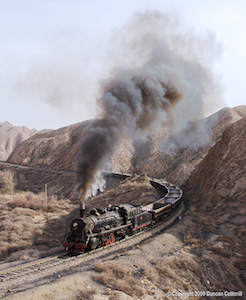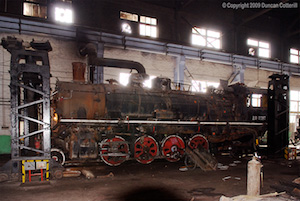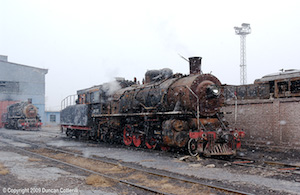Industrial Steam East and West
27 February - 12 March 2009
Report by Duncan Cotterill
Introduction
The opencast coal mine at Zhalainuoer is probably the greatest steam spectacle left in the world today but it won’t be for much longer. Railway operations within the big pit are expected to cease later this year and diesels are currently being acquired for the surface lines as well. The opportunity to visit Zhalainuoer for one last time was just too good to miss. We also visited Baiyin, a much smaller operation but with a reasonably long main line featuring semi-desert scenery and steep gradients.
Our group consisted of Peter Breeze, Robin Gibbons, Greg Howell and myself. Arrangements within China were made by Mike Ma. We had expected Tao to be our guide, as in November 2008, but he had to withdraw at the last minute so we were accompanied by a Mr Chen, also from Mudanjiang.
The Outward Journey
27 – 28 Feb 2009Greg and I met at London Heathrow and flew with Air France to Paris, where we underwent a very stringent security check before joining Peter for the onward flight to Beijing. At the x-ray machine I asked whether they wanted to scan my laptop separately. They did, and the power supply as well, and the camera battery chargers, and the cameras, and the lenses and my iPod. This only left a blower brush and a few compact flash cards in my bag. Just as well that the terminal wasn’t busy as the whole process took an inordinate amount of time and was completely pointless as everything had been scanned a couple of hours earlier at Heathrow.
We met up with Robin and Mike Ma at Beijing. Mike was accompanying Cyril Lofthus and Dave Huntsbach, who were also bound for Zhalainuoer. We all flew up to Manzhouli on the daily Hainan Airlines flight, getting a good view of the opencast mine during the approach. At Manzhouli we met up with our own guide and driver.
The hotel we had used at Zhalainuoer in early 2007 had closed and Mike wasn’t impressed with the other hotels in town so we stayed in Manzhouli and travelled to Zhalainuoer every day.
Zhalainuoer Mining Railway
28 Feb – 05 Mar 2009Deep Mine System
The deep mine operation was fairly busy but the presence of the two newly acquired diesels limited the opportunities to photograph steam workings. The two new locos are DF7G 5198 and 5199 but there is scope for confusion as several locos of the same type are employed by CR in the Manzhouli/Zhalainuoer area and often deliver empties to the mine railways Dongfanghong yard. The CR locos carry the same brown and orange livery as those on the mine railway and can only be distinguished by the Harbin Bureau shedcode on the cabside. One mine railway diesel was almost permanently on pilot duty at Dongfanghong Yard while the other worked trains to or from the various mines on the system. The yard pilot also served the washery, delivering empties and removing loads, leaving the washery pilot, SY 1601, merely to shunt the wagons backwards and forwards under the loader. As a result, we saw none of the spectacular double-headed shunt moves reported by earlier visitors. Steam still worked a reasonable number of trains to the collieries and power station, with smoke deflector fitted SY 1416 particularly active. There didn’t seem to be much of a pattern to the workings with times and destinations varying considerably from day to day.
Locos:
SY 1126, 1416, 1448, 1450, 1618 in use,
SY 0924, 1424, 1688 stored at Dongzhan, SY 1234 dumped at Dongzhan.
SY 1601 in use as washery pilot – opencast loco duty?
Opencast System
With the forthcoming closure of the opencast mine railway widely reported, there was some concern that activity levels might be disappointing. This was certainly not the case and although the number of locos in use had declined slightly from previous years, the pit was very busy with a good number of coal and spoil trains in operation as well as various construction trains, cranes etc. On several occasions we counted 16 to 18 locos in the pit at the same time but they seemed more active than in previous years. There were several areas where large scale removal of overburden was taking place and coal was being cut from a very deep seam in at least four places. As a result, trains were being loaded quickly and departures from the lower levels of the pit were usually very frequent. This was a big improvement on previous trips when equipment problems or a shortage of CR wagons meant long periods when only the spoil trains were running.
The only area that was significantly quieter than before was the line out of the mine towards Nanzhan. This was due to spoil trains running to dumps in the south-eastern corner of the pit rather than on the surface. A new servicing point at “station 510” removed the need for locos to go to Nanzhan for servicing and there was very little traffic into or out of the pit.
Both passenger trains ran daily although the working into the pit left from the unloading station rather than station 510. The coaches (1 coach for each train) were usually stabled at the unloading station and station 510 during the day but we did sometimes see the coach from 510 being taken out in the direction of Nanzhan during the day. Again, there didn't seem to be a discernable pattern to this.
Locos:
SY 0471, 0867, 0959, 1041, 1119, 1193, 1240, 1256, 1284, 1285, 1286, 1303, 1375, 1376, 1587, 1650, 1654, 1663, 1664, 1678, 1681, 1689, 3005 in use,
SY 0613, 0614, 0682, 0794, 0795, 0924, 0957, 0958, 1192, 1257, 1258, 1371, 1374, 1401, 1449, 1496, 1586, 1600, 1617, 1619, 1690 stored / dumped at Dongzhan.
It was disappointing to see that standards of cleanliness had declined over the past couple of years but not really surprising in view of the impending end of steam operation. Even former supershine locos SY 1663 and 3005 were looking really scruffy and many locos were missing their builders plates. Just as well the details of most locos were recorded before this happened. Another sign of the coming changes was the complete absence of engines undergoing anything other than minor repairs in the workshops.
The weather was excellent for most of our visit with moderate southerly winds and generally clear skies. On one morning the wind was so light that the smog in the big pit took hours to clear but on the other days it wasn’t a serious problem. This was in contrast to previous visits when a vicious north-westerly wind made photography in the pit totally pointless on most mornings. On the afternoon of 4 March the weather changed, first becoming overcast then clearing overnight but with a biting north-westerly wind.
We were able to enter the opencast pit on several occasions without any difficulty and found almost everybody either friendly or indifferent to our presence. There are a number of paths into the pit that don’t pass the control office and can be used to gain access to the lower levels. The only time we were asked to move was just before blasting took place close to where we had been standing. Once we'd moved out of harms way, nobody bothered us.
CR Manzhouli Area
Freight on the main line east from Manzhouli towards Hailaer, Qiqihaer and Haerbin was handled by DF4B and DF8B diesels based at Qiqihaer depot. Trains were heavy and relatively frequent with double heading quite common. Cross border oil and timber traffic formed a large proportion of the freight seen passing Zhalainuoer. Most trains were formed of CR rolling stock but a few trains of Russian oil tankers were seen as well. Most passenger trains were hauled by red and cream DF4Ds based at Harbin’s Sankeshu depot but a few orange DF4Bs were seen as well.
The main line through Zhalainuoer to Manzhouli is now double track and fenced off. The level crossings in Zhalainuoer have all been closed and replaced with bridges over or under the line including a couple of footbridges. Immediately west of Zhalainuoer Xi, the line has been realigned and now passes through a cutting rather than winding its way around the hillside.
A brief visit to see JF 1861 plinthed at the Russian border coincided with a TE10M double unit entering China with a trainload of timber. The JF had been used to haul Mao Zedong to a historic meeting with Russian leaders, hence its survival. I wondered whether it might have been regauged to 5’ but careful measurement using Greg’s specially calibrated boots confirmed that it was still standard gauge.
Zhalainuoer to Baiyin
05 – 06 March 2009Travelling from Manzhouli to Baiyin by train would have taken several days so flying was the only practical option. We took the daily Hainan Airlines flight from Manzhouli back to Beijing on the afternoon of 5 March then continued to Lanzhou early the following morning, also with Hainan Airlines. At Lanzhou airport we were met by our driver and continued to Baiyin in comfortable time to collect our permit from the security office before driving up the line for the afternoon passenger to Shenbutong.
We stayed at the Wansheng hotel on the western outskirts of Baiyin and travelled around on a bus provided by a Lanzhou travel agency. Permission to visit the railway had been arranged by Mike in advance and our bus carried a special pass in the front window which gave us access to the railway above Sanyelian and to the depot at Baiyin Gongsi. As has been reported elsewhere, access to Shenbutong itself is no longer allowed but there's no problem going as far as Dongchanggou.
Baiyin Mineral Railway
06 – 11 Mar 2009The main workings of interest were the passenger trains to Shenbutong, departing Baiyin Xinzhan at 07:50, 15:15 and 18:15 and taking just over 30 minutes to reach Shenbutong. These trains were always worked by an engine facing chimney first uphill, unlike the passengers to Sanyelian, which were always tender first uphill. The morning Sanyelian train departed Baiyin Xinzhan at 07:35 but the afternoon train worked empty stock from Baiyin Gongsi direct to Sanyelian, departing Gongsi around 16:10. Neither Sanyelian train ran on Saturday or Sunday but the Shenbutong trains ran every day. SY 1581 was the regular engine on the Shenbutong trains with SY 1013 working the Sanyelians.
Apart from the last day, when we left the railway shortly after midday, we saw an empty ore train going to Shenbutong every day. Timings appeared to be fairly random with departures from Baiyin around 14:30, 15:30, 11:00, 10:30 and 12:30 on the five days we saw the train run. The ore empties were chimney first uphill and hauled by SY 1047 on all but the first day when SY 2008 was in charge. Incidentally, we never saw SY 2008 again, anywhere, during our visit. The irregular freights to Sanyelian and Liugongli were tender first and worked by SY 1013 or SY 0612, or sometimes both engines, top and tail.
At the depot we were surprised to find SY 1097 under overhaul on 09 March and even more surprised to find it out in the yard in light steam on 11 March. SY 1097 is one of the two SYs from the Tiehejinchang operation north of Yaojie and has been in store at Baiyin for over a year. SY 0150, the other Tiehejinchang loco, is still in storage along with Baiyin’s SY 0965. SY 1470 was also in the storage compound at the back of the workshop when we arrived at the depot on 09 March but it was dragged out before we left and parked in front of the running shed. It was still there on 11 March. SY 1583 was cold in the running shed on 07 March and on both subsequent visits, probably awaiting minor repairs, but unlike SY 1470, it had obviously been in use a few days earlier. SY 0819 was busy doing some runs for a film crew at the beginning of our visit, coupled to a homemade boxcar and sometimes some wagons as well. This loco had only recently been repaired after a period out of use but had not received a repaint and looked really scruffy. Of the long dumped locos, SY 0194 had disappeared, leaving one JS and 2 SYs in the compound alongside the shed yard. We didn’t check the three JS in the compound south-east of Gongsi except to confirm from a distance that there were still three of them there.
Locos:
SY 0612, 0819, 1013, 1047, 1581, 2008 in use
SY 0965, 1470, 1583 cold awaiting repairs / in store
SY 0135, 0139, JS 8021, 8082*, 8224*, 8350* dumped
SY 1097 visiting loco completing overhaul
SY 0150 visiting loco awaiting overhaul (but unlikely to get it!)
* numbers not positively checked.
In addition to the steam locos we saw an orange GK1C, thought to belong to one of the factories in the Baiyin area, working a trip into Gongsi yard from the south.
The weather at Baiyin had been problematic on each of my previous visits and wasn’t brilliant this time either. We did get a few shots in reasonable light but there was never the cold weather or clear bright sunshine we enjoyed most of the time at Zhalainuoer. There was usually a layer of thin high cloud and poor visibility and high temperatures also made things difficult at times. Our last two days were totally overcast with light snow at times.
Other Baiyin Industrial Lines
We visited the North-West Copper Processing Works at lunchtime on Sunday 8 March. The works is located in a small town several km north of Baiyin and accessed by following the road that crosses the CR line on a bridge at the west end of Baiyin Shi station. The loco depot and yard are situated outside the security fence to the south of the works and are accessible without passing through security and entering the works proper. We found SY 0888 in steam in the yard with SY 1067 cold but apparently serviceable in the single road loco shed. There was no indication that any workings were planned that day although the loco crew were in attendance and very friendly.
Locos:
SY 0888 in use, SY 1067 cold serviceable.We also thought about trying to visit the Honglu Aluminium Factory where SY 1596 and 1597 are based but couldn't work out where it was.
CR Baiyin Area
A number of freights and the daily passenger train were seen on the Baiyin Xi - Changzheng - Honghui line, all powered by green DF4Bs. Heavier freights were double headed and those locos seen close up all bore Lanzhou depot codes. Much of the freight traffic appeared to be empty coal wagons going east and loaded coal trains returning west. The pilot loco at Baiyin Shi was a DF5.
